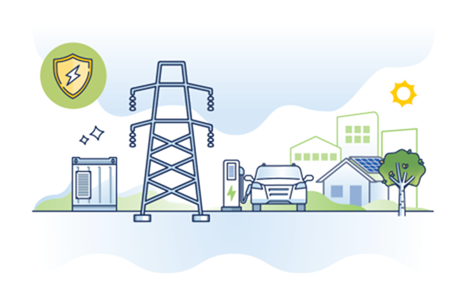Power in Transit: The U.S. Transmission Grid at a Crossroads
/Pulse – Part 3 in Our Energy Series
By Fred Carey, PE and Dawn Schilling, PE
In Parts 1 and 2 of our Pulse series, we explored the rising demand for electricity and the evolving mix of energy sources powering the U.S. economy. But generating electricity is only part of the equation. To keep the lights on, we need a robust, resilient, and modern transmission system capable of delivering that power where and when it’s needed. In this final installment, we examine the U.S. power grid—how it works, where it’s vulnerable, and what’s being done to strengthen it.
What Is the Transmission Grid—and Why Does It Matter?
The U.S. electric grid is essentially a network of three separate power grids. It consists of three major interconnections—the Eastern, Western, and Texas grids—linked by more than 600,000 miles of high-voltage transmission lines. These lines carry electricity from power plants (generation) to substations, where it’s stepped down and distributed to homes, businesses, and industries. The U.S. electric grid is primarily a century-old patchwork of independently developed systems.
But the grid is more than wires and towers. It’s a complex, real-time balancing act that must match supply and demand every second of every day. As our energy mix shifts toward renewables and our demand patterns evolve, the grid’s role becomes even more critical—and more complicated.
Where the Grid Falls Short
Despite its scale, the U.S. transmission system is aging, congested, and increasingly strained. Key challenges include:
Aging infrastructure: Much of the grid’s infrastructure was constructed in the 1960s and 1970s, and is now nearing or passing its end of lifespan.
Increasing Demand: As discussed in our previous Pulse article, increasing electrification of industries and transportation, along with new demand for AI Data Center infrastructure is increasing demand exponentially.
Interconnection Bottlenecks: Developers often face multi-year delays just to connect new generation to the grid. As of 2025, over 2,000 GW of proposed projects are stuck in interconnection queues.
Regional Fragmentation: The grid is managed by a patchwork of utilities, regional transmission organizations (RTOs), and independent system operators (ISOs), each with its own rules and priorities. This fragmentation hampers coordination and slows progress.
Climate Vulnerability: Extreme weather events—wildfires, hurricanes, heatwaves—are testing the grid’s resilience. Outages are becoming more frequent and costly, especially in regions with outdated infrastructure.
Source: FERC - https://www.ferc.gov/electric-power-markets
What’s Being Done
Federal and state agencies, utilities, and private developers are taking steps to modernize the grid:
The Bipartisan Infrastructure Law and Inflation Reduction Act include billions in funding for grid upgrades, resilience, and innovation.
An April 2025 Executive Order from the President, “Strengthening the Reliability and Security of the U.S. Electric Grid,” requires the Department of Energy (DOE) to streamline, systemize, and expedite reviews and approvals related to surges in electricity demand particularly related to AI Data Centers and increases in domestic manufacturing.
The DOE Grid Deployment Office is supporting large-scale transmission projects and regional planning efforts.
New initiatives like the National Transmission Needs Study and Transmission Facilitation Program aim to identify critical corridors, develop improved processes for monitoring the grid, and accelerate permitting.
Energy storage could play a vital role in balancing the U.S. power grid, especially as renewable sources like solar and wind expand. Unlike traditional power plants that can adjust output to meet demand, renewables often need storage to ensure a flexible and reliable supply. Institutions like NREL and Sandia National Laboratories are advancing storage technologies.
NREL and various universities and private companies are researching the use of microgrids, localized energy grids powered by any available energy source (renewable, fossil, nuclear, etc.) that can disconnect from the larger U.S. grid, to provide power for local loads, such as AI data centers or large industrial developments.
Research, testing, and deployment of distributed energy sources, such as small modular nuclear reactors, is also underway. These distributed energy sources function much like a microgrid but on an even smaller scale providing much more flexibility in siting and application in very remote areas due to their modular nature.
Still, progress is slow. Permitting hurdles, local opposition, and regulatory complexity continue to delay projects. Without faster action, the grid could become the bottleneck that holds back the entire energy transition.
Conclusion: The Grid Is the Glue
Source: Grid Deployment Office: https://www.energy.gov/gdo/about-grid-deployment-office
As we pursue increased generation capacity; electrify transportation and an expanding industry sector; and the development of AI Data Centers continues, the reliability of and the connections within the transmission grid become more and more critical. It’s not just a conduit—it’s a catalyst for economic growth, environmental progress, and national security.
At PHE, we’re committed to helping our clients navigate the complexities of energy infrastructure planning. Whether it’s siting new transmission lines, assessing environmental impacts, or supporting community engagement, we believe a stronger grid is essential to a stronger future.




